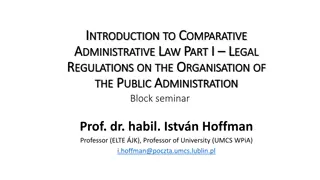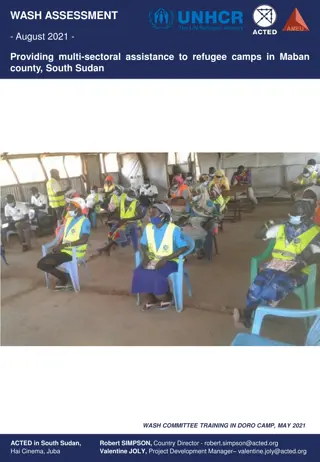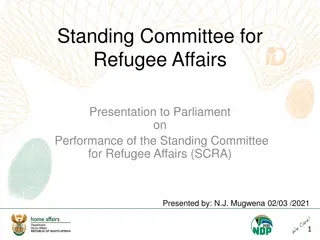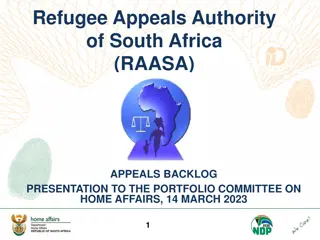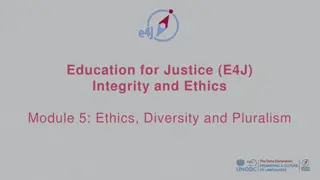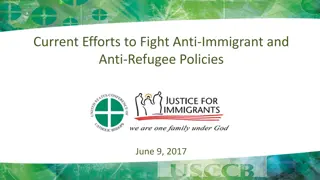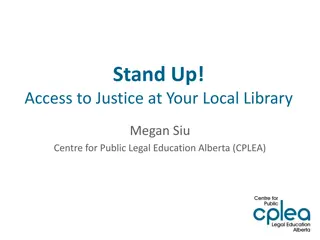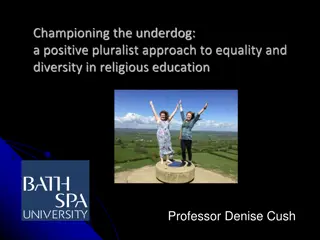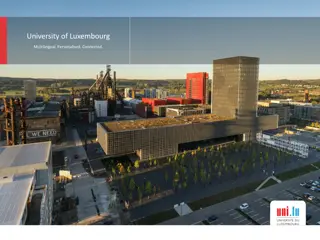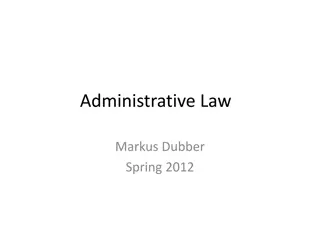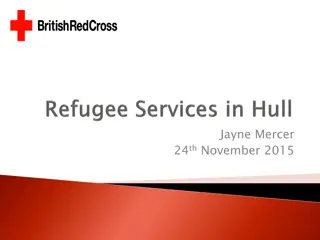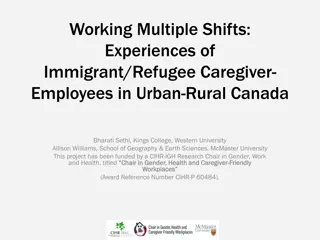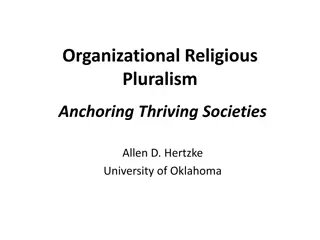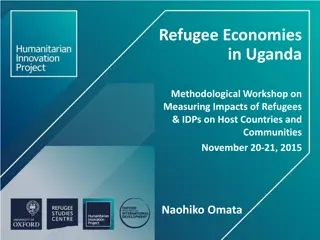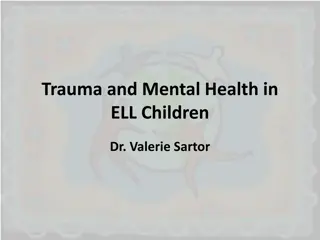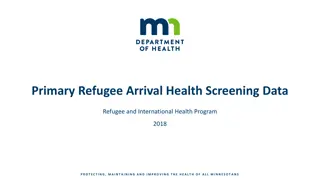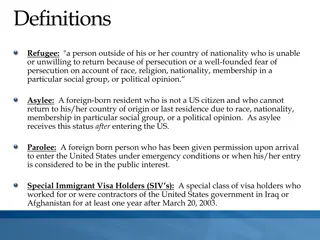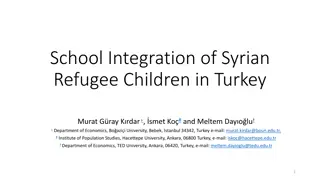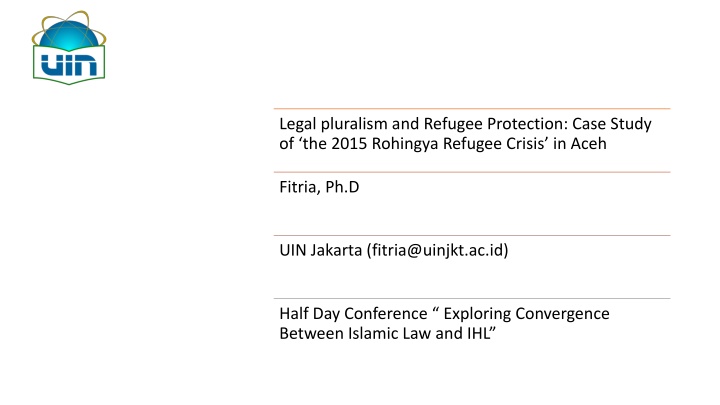
Legal Pluralism in Refugee Protection
In-depth analysis of the utilization of local customary law and Sharia in safeguarding refugees during the 2015 Rohingya crisis in Aceh, exploring the dynamics of legal pluralism and its impact on responses. This study delves into the co-existence of multiple legal systems and the actors' interpretations of law, shedding light on the complexities of governance in refugee contexts.
Download Presentation

Please find below an Image/Link to download the presentation.
The content on the website is provided AS IS for your information and personal use only. It may not be sold, licensed, or shared on other websites without obtaining consent from the author. If you encounter any issues during the download, it is possible that the publisher has removed the file from their server.
You are allowed to download the files provided on this website for personal or commercial use, subject to the condition that they are used lawfully. All files are the property of their respective owners.
The content on the website is provided AS IS for your information and personal use only. It may not be sold, licensed, or shared on other websites without obtaining consent from the author.
E N D
Presentation Transcript
Legal pluralism and Refugee Protection: Case Study of the 2015 Rohingya Refugee Crisis in Aceh Fitria, Ph.D UIN Jakarta (fitria@uinjkt.ac.id) Half Day Conference Exploring Convergence Between Islamic Law and IHL
Primary question: How was local customary (adat) law and Sharia employed/used to protect refugees? Research Questions Subsidiary questions: What are the ideas of law of the actors involved in response to the Rohingya refugee crisis in Aceh, and what do the actors experience as law? How did these ideas about the law inform/affect their responses?
legal pluralism as a situation in which two or more laws interact, and in which several legal systems operate within the same territorial area of a state. (Hooker 1975). Legal Pluralism In a given social setting, the co- existence of different legal orders, which do not belong to a single system (Griffith 1986)
Frameworks (Menskis Kite Model:2011) Natural law State law Socio-cultural norms International law
Framework Relationship of adat law, sharia and state law and another normative orders can be expressed in political and ideological statements as complementary, equivalence, or superiority of the different orders of the different social organisation ((Von Benda Beckmann and Von Benda Beckmann: 2012)
literature on legal consciousness, mainly by seminal work of Selby and Ewick of Common Place of Law . ( 1998) attempts to understand the attitude of individual or groups of people towards law by theorising varieties of legal consciousness: before the law, with the law or against the law Legal Pluralism- Legal Consciousness Another narrative of legal consciousness put forward by Halliday and Morgan is a legal consciousness as an expression of collective rejection of the authority of state law. (Halliday and Morgan: 2013)
Governing Refugees: Justice, Order and Legal Pluralism : Kirsten McConnachie (2014) Legal pluralism and Refugee Protection (Literature Review) Strengthening the Rule of Law on the Margins: Experiences from Za atari Refugee Camp, Jordan : George Riach and Zoe James (2016) Expanding the Frontiers of Refugee Law: Developing a Broader Law of Asylum in theMiddle East and Europe : Martin Jones (2017) Hospitality as a Horizon of Aspiration (or, What the International Refugee Regime Can Learn from Acehnese Fishermen) : Anne McNevin and Antje Missbach (2018)
The main sites of the Crisis: in Aceh and in Jakarta; Fieldworks (14 July-17 September 2018) In Aceh, the interviews and the Focus Groups were conducted in a wide range of locations: Banda Aceh (the Capital), Aceh Utara Regency (North Aceh) and Kota Langsa (Langsa City), Aceh Timur (East Aceh), Peurlak, Bireun, and Lhoksemawe; Most of the interviews were conducted in person and lasted for 1-1,5 hours whereas the FGDS lasted for 3- 3,5 hours.
Fieldworks (Semi Structured Interviews]
Fieldworks (Focus Groups)
Significance of Law: What drove the actors to take Personal Account Humanity Sharia Customary law Professional Account part in refugee protection? Human Rights Customary law of the sea
..Our understanding of who they are. They are us. We are them. Who are the Rohingyas? They are us. Just like any other refugees, they are us. We're both human being. That's all. So when they suffer, we suffer too.. (FG3-4) .. Well, maybe because we have the same concerns, the same destiny. Both of us had undergone a very traumatic conflict. This conflict made the Acehnese easy to put themselves on the refugees shoes.. I-12 Significance of Law: What drove the actors to take part in refugee protection? ..we re as human rights activists, we handled human rights issues all this time, but, we saw that the attention towards the refugees was insignificant.. I-28 .. Our organisation got involved in refugee protection because it is our job.. I-33 ..That s something we should think of. What if we don t take them? With the wind like that or their machine couldn t function. There s no anchor. It s running out of food. There s a big wave, then drowned. It s a sin. There is a risk..it s qur an teaching.. I-20 .. It is our duty based on our customary law of Acehnese that whoever got troubles in the sea may seek for help from us and it is a must that we help them.. I-25
Law as rules issued by state Law as Police What is the Law? Law as a set of rules Law as Customary/Adat Law Law as Human Rights Law as International Law Law as Sharia Law as Justice Law as a tool of social engineering
.. Speaking about the law, its related to the police. I don t have anything in mind.. I-21 ..I m actually a person who believes that there s a standard value, universal value. The value could be the law or could be something unwritten, but it s already recognized.. I-28 What is the Law? . Law is not just a state law which is made by the state. There is also a customary law which is made by a particular society although perhaps the range of power is less strong than a state law.. I-34 The law is there to manage anything. So it is more, what is it.., whether to have more justice, prosperity. Not only from the state. As a Muslim we ve even got sharia. . I-19
the accounts of the actors in rescuing and providing aid to Rohingya refugees were multiple, as many people gave more than one account. These accounts could be classified into two types: legally driven motivations (e.g. adatlaw of the sea accounts) and non-legally driven motivations (e.g. personal accounts).: Findings the actors background-mainly Acehnese- shaped their accounts and responses to the crisis, as they hold more than one identity. Acehnese fishermen, for example, were also not only members of the fishery community, but also members of the religious community, as it is common for them to take part in religious activities or congregations in their neighbourhood. Similarly, to fishermen, senior local government staff are not only a part of the state apparatus, but are also a part of adat communities, as they obey adat law. However, the accounts of many non-Acehnese actors were mostly shaped by their roles or professional backgrounds.
the role of law, especially adat law (including adat law of the sea) and sharia, are very significant in shaping the actors response to the Rohingya refugee crisis. Importantly, the obligatory norm to rescue those found in distress at sea has been preserved for a long time, as norms have been passed on through families, and are maintained by the fishery communities. Similarly, the norm of pamulia jamee (rules of honouring the guest), inspired by sharia, has been preserved and passed down within adat communities Findings
Pesom gasin peudeuh kaya, meaning hide your poverty, then you ll look rich . Show people that we are capable of serving guests, although in reality we are not rich. That has become something special among the Acehnese. It has been implanted in us (FGD1-3) Legal Pluralism (Relation between normative orders) Pamulia jameewas implanted in ourselves, as it was our ancestors heritage (FGD1-1) The guest will be given priority. That s the Islamic way; that s the way the Prophet Muhammad applied when he served guests. The Prophet would prioritise whoever needed the food, even though he himself didn t have much food to share. So, there is no difference between what the Prophet taught us and what we have practised in our own society (FGD1-1)
..Relationship of adat law, sharia and state law and another normative orders can be expressed in political and ideological statements as complementary, equivalence, or superiority.. In the context of Aceh, the relation of adat law and sharia is Overlapped.
Conclusions 1). In contrast to the mainstream research of refugee studies, my research applies a bottom-up approach. The concept of law, in my view, is not confined to state and/or international law, but includes non-state-made law (e.g. adatlaw). The empirical findings reveal that people s understanding of the law is plural and complex. Moreover, the main driving force behind people protecting refugees is neither international nor national law ; 2). The findings suggest that we cannot underestimate the location itself, in which the refugees are stranded, then are rescued and helped by mainly local people. A study in a specific context into the protection of Rohingya refugees in a specific region such as Aceh adds a contribution in the literature; 3). Werner Menski s kite model of legal pluralism and Benda Beckmann idea on the relation between law and another normative orders are incomplete since the relation between the normative orders not only superior, complementary or equivalent but can also be overlapped


